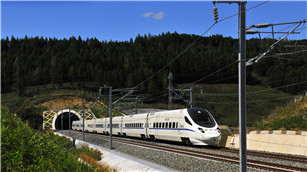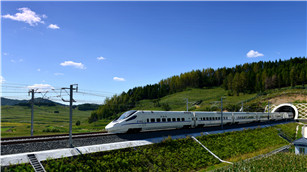Event promotes trade along Belt and Road
By Zhong Nan And Liu Mingtai
( China Daily )
2015-09-25
Initiatives focus on investment, finance, and infrastructure projects
The 10th China-Northeast Asia Expo will help China enhance its investment, trade, financial cooperation, infrastructure development and policy understanding with its neighbors and nations along the Belt and Road Initiative, said senior officials.
The Silk Road Economic Belt and the 21st Century Maritime Silk Road initiatives were proposed by President Xi Jinping in 2013, with the purpose of rejuvenating the two ancient trade routes and further opening up markets for Chinese companies.
Bayanqolu, Party secretary of Jilin province, said China's "going global" strategy of exporting mature industries, diversifying its foreign exchange reserves and investing abroad are already being implemented along the Belt and Road and its progress will draw a new landscape for the opening-up of Northeast China and neighboring countries.
The six-member region, comprising China, Russia, Mongolia, the Democratic People's Republic of Korea, the Republic of Korea and Japan, represents a market with a population of 1.7 billion and more than 20 percent of the world's economic aggregate.
"Promoting an export-oriented economy will help resolve most of the domestic economic problems. This is a successful example that is often adopted by developed countries such as the United States, Germany and the United Kingdom to upgrade their industries and maintain their economic prosperity," said Bayanqolu.
In the past, China's economic development mainly relied on trade, namely with exports of goods and services. But with the country's economic growth slowing over the past two years, China has moved production facilities abroad and increased its technology collaboration with countries in Central and Southeast Asia.
Ling Ji, director-general of the department of Eurasian affairs at the Ministry of Commerce, said global economic recovery still faces many uncertainties and challenges, including weak investment momentum and unstable financial markets. At the same time, many countries in the Northeast Asian region face difficulties in boosting exports and creating jobs.
Like China's Belt and Road Initiatives, Russia is also raising capital to develop its Far East region, while the Republic of Korea is promoting its Eurasian initiative. Ling said: "The expo can assist these countries to gain technologies, products and investment such as infrastructure development, logistics services, high-speed trains and telecommunication equipment that are necessary to achieve their goals."
The China-ROK Free Trade Agreement has also been a successful link point for China's Belt and Road Initiative and ROK's Eurasian initiative. It is expected to have a profound impact on jointly advancing the Belt and Road Initiative and Eurasian economic integration.
China and the Republic of Korea are important economies in Northeast Asia and the Asia-Pacific region, with its economic aggregate accounting for 25 percent of the APEC total, while trade in goods is about 29 percent of all the member countries.
"The success of the China-ROK FTA has meaningful significance to Northeast Asian regional cooperation and Asia-Pacific regional economic integration, and is conducive to the ongoing China-Japan-ROK FTA negotiations, as well as other ongoing free trade agreement talks along the Belt and Road Initiative," said Ling.
Companies within the Northeast Asia region are encouraged to use their own currency to bag deals and build e-commerce platforms to save on both operating and trading costs, as well as carrying out closer cooperation between customs authorities to simplify clearance procedures.
Zhuang Yan, Jilin's vice-governor, said Jilin will use the platform built by the expo to promote strategic consensus among countries and for transformation. The province will go ahead with the integration of the Changchun-Jilin-Tumen Development Pilot Zone, a priority development area with mature individual foundation, into the Belt and Road Initiative.




